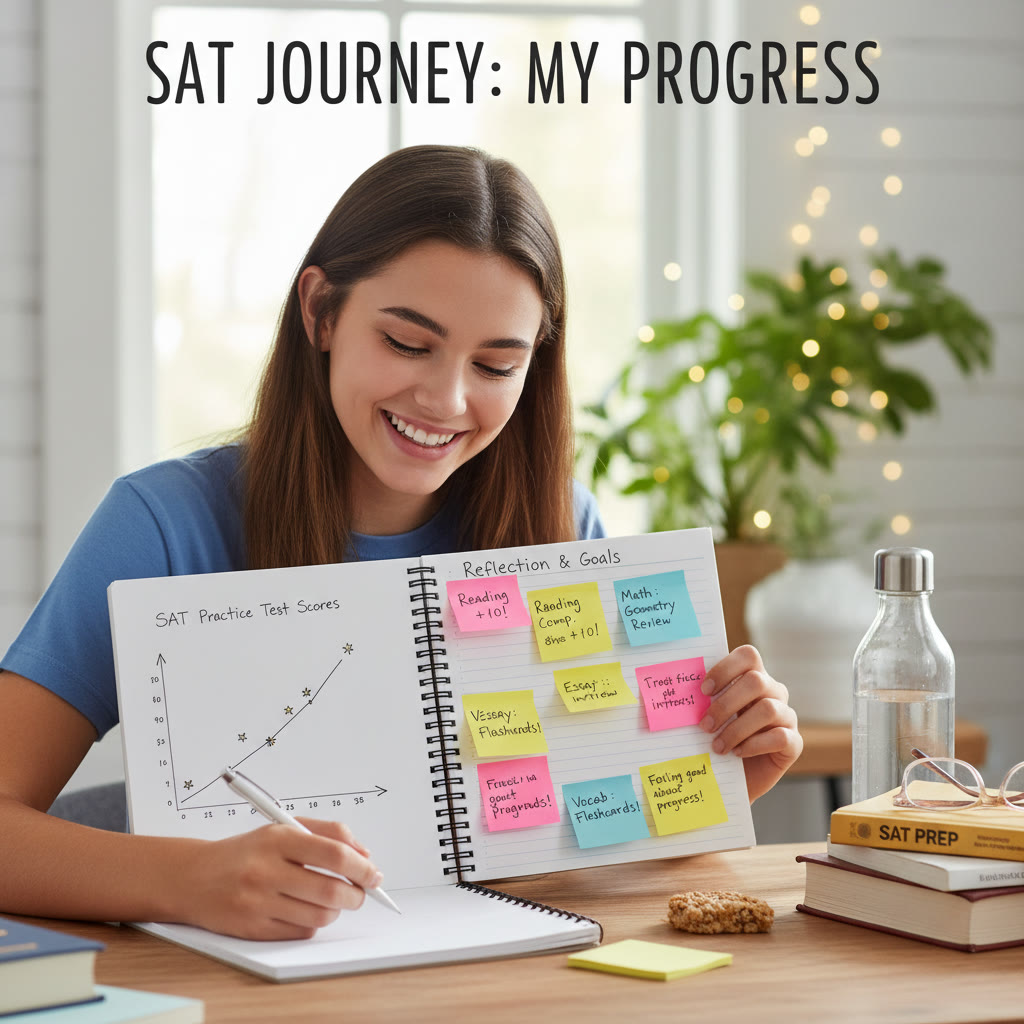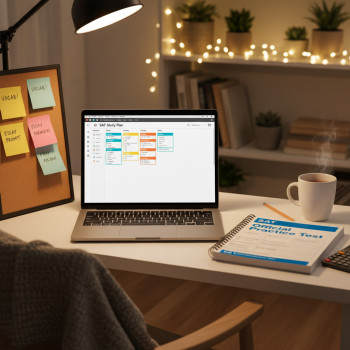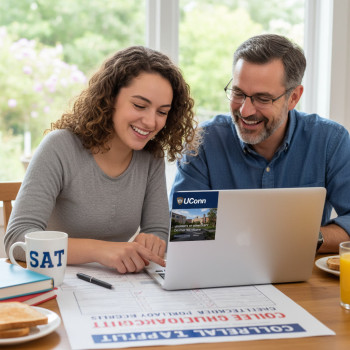The Role of Self-Belief in SAT Success
When you sit down for the SAT, the paper (or screen) in front of you contains familiar-looking math problems, reading passages, and a timer that quietly tugs at your attention. But beneath the questions and the clock is a quieter, more powerful force: the story you tell yourself about who you are as a test-taker. That story—self-belief—shapes how you prepare, how you practice, and how you perform on test day.
Why self-belief matters more than you might think
Self-belief isn’t magic. It’s a mix of expectation, focus, and the mental energy you bring to practice sessions and exam moments. Students who believe they can improve are more likely to try harder, persist after a bad practice test, and apply strategies instead of panicking. In contrast, doubt often shows up as hesitation, second-guessing, and wasted time—exactly the things that cost points on a timed exam.
Research in education and psychology has repeatedly shown that mindset affects learning. A growth mindset—the belief that abilities can be developed through effort and strategy—correlates with better study habits, greater resilience, and steady improvement. For the SAT, which rewards pattern recognition, strategy, and stamina, that resilience and consistency are priceless.
Self-belief versus raw ability: it’s not an either/or
Let’s be honest: content knowledge and strategy matter. The SAT is scored from 400 to 1600, with two main sections—Evidence-Based Reading and Writing (EBRW) and Math—and the optional essay has been discontinued. A student who has never practiced algebra or critical reading will struggle no matter how confident they feel. But confidence amplifies what you do know and helps you learn what you don’t.
Think of ability as the engine and self-belief as the fuel. Without fuel, the engine sputters; without an engine, fuel does nothing. The sweet spot for SAT success is where effective study techniques meet steady self-belief.
How self-belief changes behavior: small shifts, big results
- Persistence: Confident students are more likely to return to a difficult practice section until they master it.
- Risk management: When you trust your preparation, you’re better at choosing when to guess, when to skip, and when to dig into a tricky problem.
- Focus under pressure: Belief reduces the intrusive thoughts that break concentration during long reading passages or multi-step math problems.
- Better use of feedback: Students who expect to improve treat mistakes as information, not proof of failure.
A realistic look: example comparisons
Imagine two students with similar baseline abilities and study hours. One holds a fixed mindset: “I’m not a math person.” The other believes they can improve: “I can get stronger with practice.” Over a typical three-month prep window, the first student might stop early when progress plateaus, avoid hard problems, or misread feedback. The second pushes through plateaus, seeks targeted help, and converts weaknesses into strengths. That difference in approach often shows up as a 50–150 point gap on the SAT—real traction for college admissions.
Table: How mindset and study choices interact (hypothetical illustration)
| Student Profile | Weekly Study Hours | Mindset | Typical Progress Over 12 Weeks (SAT points) | Key Behavior |
|---|---|---|---|---|
| Alex | 6 | Fixed | +20–40 | Repeats easy practice, avoids weaknesses |
| Bri | 6 | Growth | +70–120 | Targets weaknesses, seeks feedback |
| Chris | 12 | Mixed | +60–90 | Practices more, inconsistent strategy |
| Dana | 12 | Strong growth | +120–180 | Deliberate practice, expert guidance |
This table is illustrative: progress depends on the quality of practice, not just hours. But it highlights a reliable pattern—students with a constructive mindset use the same hours far more effectively.
Practical strategies to build and maintain self-belief
Self-belief can be trained. Below are concrete techniques you can fold into your SAT prep right away.
- Set micro-goals: Replace vague aims like “do better” with specific, short-term goals: “get 8/10 algebra practice problems correct this week.” Micro-wins build confidence incrementally.
- Track progress visually: A score log or a progress graph makes improvements undeniable. When you can see the upward trend, belief follows.
- Practice reflection: After each practice test, jot down what you did well and one concrete action for next time. Reflection turns raw experience into learning.
- Balance challenge and success: Tackle problems that are just beyond comfortable—hard enough to require effort, easy enough to eventually solve. That sweet spot boosts mastery and confidence simultaneously.
- Use targeted feedback: Instead of redoing an entire section, focus on error patterns (e.g., misreading prepositions in reading, weak algebra substitutions). Fixing targeted errors builds trust in your ability to improve.
- Control the controllables: Study schedule, sleep, nutrition, and test-day logistics are within your control. Mastering these reduces anxiety and supports belief.
Sample weekly routine that builds confidence
This sample balances deliberate practice, reflection, and rest—the three pillars of steady progress.
| Day | Activity | Purpose |
|---|---|---|
| Monday | Short diagnostic + one focused content block (e.g., geometry) | Identify mistakes, maintain momentum |
| Tuesday | Targeted practice (timed sets of 10 problems) | Deliberate practice on weak areas |
| Wednesday | Reading comprehension strategies + 1 full passage | Improve speed and accuracy |
| Thursday | Mistake review (why each error happened) | Turn errors into learning |
| Friday | Practice test (half-length) or mixed practice | Apply strategies under pressure |
| Saturday | Rest or light review (vocabulary, mental math) | Recharge and consolidate |
| Sunday | Reflection journal + plan for the week | Celebrate wins, set micro-goals |
Quick mental habits to use during practice and on test day
- Pre-question ritual: Take three slow breaths before each section to reset focus and reduce racing thoughts.
- Begin with evidence: For reading questions, underline the sentence that supports your answer. For math, briefly restate the problem in your own words. These small habits anchor thinking and reduce doubt.
- Time-check mindset: Instead of panicking when a timer shows limited time, plan two micro-actions: estimate time per question and decide where you’ll skip if needed. Planning reduces stress.
- Anchor statements: Use short, positive cues: “I’ve practiced this,” “I can try one path,” or even “Small step.” These phrases interrupt negative spirals.
Dealing with setbacks without losing belief
Setbacks happen—practice tests with a disappointing score, a careless error on a formula you knew, a day when focus slips. How you interpret setbacks determines whether they become discouragement or fuel for learning.
- Normalize variability: Test performance varies day to day. A single score is data, not destiny.
- Ask diagnostic questions: After a low score, ask “What went wrong?” rather than “Why am I bad at this?” Diagnostics lead to fixes; generalizations lead to self-blame.
- Create a short recovery plan: Choose one small corrective action—like reworking five missed problems—and measure the result. Small wins restore confidence faster than broad promises.

Realistic case studies: small stories, useful lessons
Case 1: Jamal consistently scored 1100 on practice tests. He believed he was “bad at grammar,” so he avoided sentence structure practice. After working with a tutor who helped him set 15-minute daily grammar micro-goals and reflect on each mistake, he learned targeted rules and raised his grammar accuracy. Over three months his score climbed to 1250. The change wasn’t instant—it was built on repeated, focused small wins that rewired his belief about what he could improve.
Case 2: Priya studied for many hours each week but burned out two weeks before her test, panicked, and underperformed. She had the knowledge but not a strategy for rest and mental preparation. By restructuring her schedule with planned rest days and brief mindfulness exercises, she regained focus. Her practice scores stabilized and then improved, demonstrating how believing in your ability to recover and adapt supports long-term performance.
How guided support strengthens belief (and why it matters)
Guidance helps because it shortens the feedback loop. When you study alone, you may not see the most efficient path forward, and small setbacks can feel like confirmation of limits rather than temporary challenges. Personalized tutoring provides three things that strengthen self-belief quickly:
- Targeted feedback: Expert tutors identify specific misconception patterns and give actionable fixes.
- Accountability and structure: Regular check-ins keep momentum and highlight progress you might otherwise miss.
- Adaptive challenge: Skilled tutors progressively raise difficulty to expand capability without overwhelming students.
Sparkl’s personalized tutoring and benefits—like 1-on-1 guidance, tailored study plans, expert tutors, and AI-driven insights—fit neatly into this approach. With a tutor who can pinpoint small errors, set realistic micro-goals, and show progress visibly, students often build confidence faster than they would alone. When that belief is married to deliberate practice, test-day performance improves.
Exam day: rituals that protect belief and performance
Test day is a performance full of small decisions. A calm, consistent routine preserves self-belief and keeps your skills accessible when it counts.
- Morning routine: Eat a familiar breakfast, hydrate, and arrive early. Familiarity reduces distractions.
- Warm-up questions: Do a three-question warm-up—one reading, one math—30 minutes before testing (if allowed by test center rules or in your practice warm-ups). Success in a tiny, low-stakes task primes confidence.
- Micro-breaks: Use official breaks to stand, shake out tension, and reset with three deep breaths.
- Recovery plan: If you miss a question, practice a two-step response: note it, move on, and if possible, return with a calm fresh look. Don’t let one mistake narrate the rest of the test.
Turning knowledge into belief: an action checklist
Use this checklist over a month to convert strategies into habits.
- Keep a score log and mark three specific improvements each week.
- Set one micro-goal for each study session and review it at the end.
- Choose one recurring error pattern and create a 2-week repair plan.
- Schedule at least one mock test under timed conditions every two weeks.
- Find a tutor or mentor for targeted feedback—short, focused sessions beat long, unfocused ones.
- Celebrate small wins: improved timing, fewer careless errors, clearer passage maps.

How to choose support that builds lasting belief
Not all help is equally empowering. When selecting resources—whether a tutor, a study program, or an app—look for these qualities:
- Evidence of adaptive teaching: The resource should adjust to your weaknesses, not force you into a one-size-fits-all plan.
- Clear feedback mechanisms: You want explanations that teach you to think differently, not just give answers.
- Focus on strategy and reflection: Tutors who encourage reflection help you internalize lessons and build confidence.
- Positive reinforcement with realism: Encouragement is useful when paired with honest, actionable critiques.
Sparkl’s personalized tutoring approach—combining 1-on-1 guidance, tailored study plans, expert tutors, and AI-driven insights—offers a blend of structure and personalization that many students find accelerates both skill and belief. The key is to use that support to create habits you can maintain independently, so belief becomes intrinsic rather than externally propped up.
Final thoughts: self-belief is practiceable and practical
Self-belief is not a personality trait you either have or don’t. It’s a skill you cultivate, one micro-win at a time. For SAT prep, belief affects persistence, decision-making, and resilience—qualities that turn practice into score improvement. Combine focused study, reflective habits, and the right kind of help, and your confidence will follow the evidence: measurable progress.
So, start small. Set a micro-goal for this week, track it visibly, and reflect honestly. If you can, get targeted feedback—maybe a short 1-on-1 session that points out one high-impact change. Over weeks, these choices create a quieter, stronger voice before the test: “I have prepared. I can handle this.” That voice is as important as algebra or grammar on the day you walk into the test center.
Quick start: three actions to build belief today
- Log one practice test and highlight three improvements—no matter how small.
- Create a 15-minute micro-practice for a weak topic and commit to it for five days.
- Schedule one short feedback session with an expert to target your single biggest error type.
Confidence combined with strategy is not wishful thinking—it’s an evidence-based path to better performance. Put in deliberate practice, lean on smart feedback when you need it, and watch how belief follows results. Good luck—you can do this.

















No Comments
Leave a comment Cancel